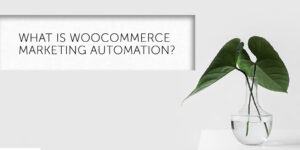The dream of marketers is to send personalized content to leads at precisely the moment it is likely to have the most effect. Although most WooCommerce hosting clients don’t have a multi-dimensional trove of data about shoppers, we do have clues that can be used to personalize and schedule content with a positive effect on conversion rates and eCommerce revenue.
Shoppers interact with WooCommerce stores: they browse products, put them in carts, make purchases, abandon carts, read blog articles, send support emails, visit and stop visiting, leave reviews, and more. Each event presents retailers with a chance to engage with their customers.
If that sounds complicated and time-consuming, that’s because it is. There are so many different processes involved in marketing that it is easy to neglect areas that might have an impact on the bottom line. As a retailer, you are focused on getting customers to your store with inbound marketing and advertising, improving the eCommerce experience with conversion rate optimization, building a brand, supporting customers, and more.
Marketing automation reduces the labor involved in marketing by automatically sending emails and other communications when they are relevant.
Let’s have a look at some examples.
Sign-Up Emails
When a customer creates an account on your store, you have an opportunity to engage them with content and promotions to help them understand your brand and the products you sell.
Abandoned cart reminders
As I have written elsewhere on this blog, it is more common for eCommerce customers to abandon carts than it is for them to make a purchase. Well-timed emails that remind customers of the products they selected can decrease abandonment rates substantially, especially if they include a coupon code or promotion.
Win-back programs
Here, engagement is triggered by something the shopper doesn’t do, namely visiting the store or buying a product. Win-back emails are intended to give shoppers who have not visited recently a good reason to do so.
In this article I have focused on email, but there are marketing automation solutions for a wide range of platforms, including social media, SMS, advertising.
Marketing Automation And WooCommerce
WooCommerce marketing automation can be implemented as an integration to a third-party marketing automation platform or as a plugin that provides similar functionality.
Marketo is a leading eCommerce marketing automation platform, and although it doesn’t provide a WooCommerce plugin, it is possible to move WooCommerce customers into Marketo via Zapier.
HubSpot, another prominent marketing automation provider, benefits from a third-party WooCommerce plugin that provides excellent integration and real-time data syncing between a WooCommerce store and the HubSpot platform.
AutomateWoo is a premium WooCommerce plugin that includes a wide range of marketing automation capabilities. Each of the marketing automation examples I mentioned – sign-up, abandoned cart, and win-back programs — are possible with AutomateWoo, in addition to card expiry notifications, product recommendations, SMS notifications, and more.
Automating WooCommerce marketing helps retailers to take advantage of the many opportunities for engagement with shoppers without the massive investment of time and money it would take to do it manually.


